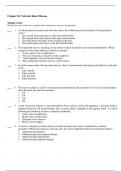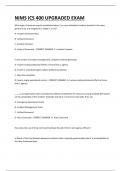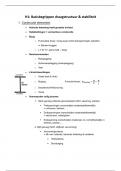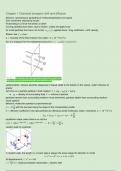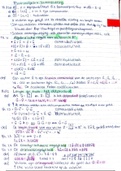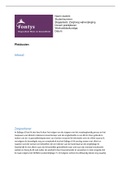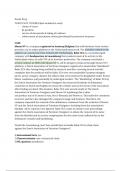Chapter 18, Valvular Heart Disease
Multiple Choice
Identify the choice that best completes the statement or answers the question.
1. At which intercostal space does the nurse place the stethoscope for auscultation of the pulmonic
valve?
1. The second intercostal space in the left sternal border
2. The second intercostal space in the right sternal border
3. The fifth intercostal space in the midclavicular line
4. The fourth intercostal space in the left sternal border
2. The registered nurse is teaching a client about medical treatment to prevent thromboemboli. Which
response by the client indicates effective learning?
1. “I can expect to be on antibiotics.”
2. “The use of diuretics will prevent the condition.”
3. “Anticoagulants work to prevent clotting.”
4. “Beta-adrenergic blockers are key in prevention.”
3. In which manner does the nurse document a client’s heart murmur that begins just before S 2 and ends
at S2?
1. Late systolic
2. Early systolic
3. Late diastolic
4. Early diastolic
4. The nurse evaluates a client’s heart murmur and determines the murmur to be loud. In which manner
does the nurse rate the heart murmur?
1. 1/6
2. 3/6
3. 2/6
4. 6/6
5. A left ventricular impulse is seen through the chest wall of a client. On palpation, a diastolic thrill is
palpated along the left sternal border, and a systolic thrill is palpable in the jugular notch. To which
pathological condition are these symptoms attributed?
1. Aortic valve insufficiency
2. Mitral valve insufficiency
3. Tricuspid valve stenosis
4. Mitral valve prolapse
6. A nurse is caring for a client who has an artificial heart valve and is scheduled for a dental
procedure. Which precautionary measure does the nurse implement before the dental procedure?
1. Administering diuretics
2. Administering anticoagulant therapy
3. Administering beta-blockers
4. Administering antibiotic therapy
, 7. Which condition is likely to be the cause of a new heart murmur in an older adult client?
1. Aortic valve sclerosis
2. Myocardial infarction
3. High blood pressure
4. Low blood pressure
8. A client presents with dyspnea, cough, fatigue, and orthopnea. On auscultation, there is an opening
snap and a diastolic murmur heard at the fifth intercostal space in the left sternal border. The client
undergoes an echocardiogram to validate a pathological condition. Which pathological condition is
the client most likely to have?
1. Mitral valve stenosis
2. Hypertrophic cardiomyopathy
3. Aortic valve stenosis
4. Aortic valve insufficiency
9. Which event needs to be ruled out in a client who has a long-standing history of mitral valve stenosis
and presents with tachycardia, an irregular pulse, and left-sided weakness?
1. Ischemic stroke
2. Myocardial ischemia
3. Left ventricular ischemia
4. Right ventricular failure
10. The nurse is auscultating a client’s heart sounds and notices a murmur. Which differentiates a heart
murmur that is caused by mitral valve stenosis from one that is caused by other mitral valve
disorders?
1. Midsystolic murmur
2. Opening snap followed by a diastolic murmur
3. Holosystolic murmur
4. Late systolic murmur
11. A client presents with paroxysmal nocturnal dyspnea (PND) and chest pain. On auscultation, the
client is found to have a holosystolic murmur at the fifth intercostal space in the left sternal border.
Which condition warrants the client undergoing an echocardiogram for validation of the disease?
1. Aortic valve insufficiency
2. Mitral valve insufficiency
3. Tricuspid valve stenosis
4. Mitral valve prolapse
12. The nurse who is trained in the gold standards for coronary care has to use the most sensitive method
to evaluate an intracardiac lesion. Which method does the nurse select?
1. Electrocardiogram (ECG)
2. Coronary angiography
3. Echocardiography
4. Chest x-ray
13. How does Ebstein’s anomaly lead to a small right ventricular chamber?
1. The mitral valve leaflets push into the right ventricle, creating a small right
ventricular chamber.
, 2. A displaced tricuspid valve lowers into the right ventricle, creating a small right
ventricular chamber.
3. The pulmonic valve pushes into the right ventricle, creating a small right
ventricular chamber.
4. The aortic valve pushes into the right ventricle, creating a small right ventricular
chamber.
14. A client presents with dyspnea, exertional dyspnea, and exertional syncope. An echocardiogram
shows a diminished left ventricular ejection fraction. Which is the reason for prescribing dobutamine
to the client?
1. To enhance arterial circulation
2. To reduce the risk of coagulation
3. To augment the cardiac output
4. To diminish the effects of ventricular failure
15. While evaluating a client for a heart murmur, the nurse auscultates the murmur with the bell of a
stethoscope. For which type of heart murmur is the nurse assessing?
1. A high-pitched murmur
2. A low-pitched murmur
3. A crescendo murmur
4. A decrescendo murmur
16. In which manner does the nurse distinguish a grade 5 heart murmur from a grade 6 heart murmur?
1. A grade 5 heart murmur is heard with the diaphragm of a stethoscope, whereas a
grade 6 heart murmur isNhU
eaRrdSI
wNithGtThB
e.beCllOoM
f a stethoscope.
2. A grade 5 heart murmur may be heard when a stethoscope is partly off the chest
wall, whereas a grade 6 heart murmur is heard when a stethoscope is completely
off the chest wall.
3. A grade 5 heart murmur is moderately loud, whereas a grade 6 heart murmur is
loud and has a palpable thrill.
4. A grade 5 heart murmur is faint, whereas a grade 6 heart murmur is moderately
loud.
17. Which does the nurse hear when auscultating heart sounds in a client who has hypertrophic
cardiomyopathy?
1. A high-pitched, blowing, decrescendo murmur
2. An opening snap after S2
3. A harsh, diamond-shaped systolic murmur
4. A blowing holosystolic murmur
18. A client is diagnosed with mitral annular calcification and has regurgitation of blood into the left
atrium and the pulmonary vasculature. Which treatment does the nurse anticipate for the client?
1. Beta-blockers
2. Angiotensin-converting enzyme (ACE) inhibitors
3. Diuretics
4. Digitalis
Multiple Choice
Identify the choice that best completes the statement or answers the question.
1. At which intercostal space does the nurse place the stethoscope for auscultation of the pulmonic
valve?
1. The second intercostal space in the left sternal border
2. The second intercostal space in the right sternal border
3. The fifth intercostal space in the midclavicular line
4. The fourth intercostal space in the left sternal border
2. The registered nurse is teaching a client about medical treatment to prevent thromboemboli. Which
response by the client indicates effective learning?
1. “I can expect to be on antibiotics.”
2. “The use of diuretics will prevent the condition.”
3. “Anticoagulants work to prevent clotting.”
4. “Beta-adrenergic blockers are key in prevention.”
3. In which manner does the nurse document a client’s heart murmur that begins just before S 2 and ends
at S2?
1. Late systolic
2. Early systolic
3. Late diastolic
4. Early diastolic
4. The nurse evaluates a client’s heart murmur and determines the murmur to be loud. In which manner
does the nurse rate the heart murmur?
1. 1/6
2. 3/6
3. 2/6
4. 6/6
5. A left ventricular impulse is seen through the chest wall of a client. On palpation, a diastolic thrill is
palpated along the left sternal border, and a systolic thrill is palpable in the jugular notch. To which
pathological condition are these symptoms attributed?
1. Aortic valve insufficiency
2. Mitral valve insufficiency
3. Tricuspid valve stenosis
4. Mitral valve prolapse
6. A nurse is caring for a client who has an artificial heart valve and is scheduled for a dental
procedure. Which precautionary measure does the nurse implement before the dental procedure?
1. Administering diuretics
2. Administering anticoagulant therapy
3. Administering beta-blockers
4. Administering antibiotic therapy
, 7. Which condition is likely to be the cause of a new heart murmur in an older adult client?
1. Aortic valve sclerosis
2. Myocardial infarction
3. High blood pressure
4. Low blood pressure
8. A client presents with dyspnea, cough, fatigue, and orthopnea. On auscultation, there is an opening
snap and a diastolic murmur heard at the fifth intercostal space in the left sternal border. The client
undergoes an echocardiogram to validate a pathological condition. Which pathological condition is
the client most likely to have?
1. Mitral valve stenosis
2. Hypertrophic cardiomyopathy
3. Aortic valve stenosis
4. Aortic valve insufficiency
9. Which event needs to be ruled out in a client who has a long-standing history of mitral valve stenosis
and presents with tachycardia, an irregular pulse, and left-sided weakness?
1. Ischemic stroke
2. Myocardial ischemia
3. Left ventricular ischemia
4. Right ventricular failure
10. The nurse is auscultating a client’s heart sounds and notices a murmur. Which differentiates a heart
murmur that is caused by mitral valve stenosis from one that is caused by other mitral valve
disorders?
1. Midsystolic murmur
2. Opening snap followed by a diastolic murmur
3. Holosystolic murmur
4. Late systolic murmur
11. A client presents with paroxysmal nocturnal dyspnea (PND) and chest pain. On auscultation, the
client is found to have a holosystolic murmur at the fifth intercostal space in the left sternal border.
Which condition warrants the client undergoing an echocardiogram for validation of the disease?
1. Aortic valve insufficiency
2. Mitral valve insufficiency
3. Tricuspid valve stenosis
4. Mitral valve prolapse
12. The nurse who is trained in the gold standards for coronary care has to use the most sensitive method
to evaluate an intracardiac lesion. Which method does the nurse select?
1. Electrocardiogram (ECG)
2. Coronary angiography
3. Echocardiography
4. Chest x-ray
13. How does Ebstein’s anomaly lead to a small right ventricular chamber?
1. The mitral valve leaflets push into the right ventricle, creating a small right
ventricular chamber.
, 2. A displaced tricuspid valve lowers into the right ventricle, creating a small right
ventricular chamber.
3. The pulmonic valve pushes into the right ventricle, creating a small right
ventricular chamber.
4. The aortic valve pushes into the right ventricle, creating a small right ventricular
chamber.
14. A client presents with dyspnea, exertional dyspnea, and exertional syncope. An echocardiogram
shows a diminished left ventricular ejection fraction. Which is the reason for prescribing dobutamine
to the client?
1. To enhance arterial circulation
2. To reduce the risk of coagulation
3. To augment the cardiac output
4. To diminish the effects of ventricular failure
15. While evaluating a client for a heart murmur, the nurse auscultates the murmur with the bell of a
stethoscope. For which type of heart murmur is the nurse assessing?
1. A high-pitched murmur
2. A low-pitched murmur
3. A crescendo murmur
4. A decrescendo murmur
16. In which manner does the nurse distinguish a grade 5 heart murmur from a grade 6 heart murmur?
1. A grade 5 heart murmur is heard with the diaphragm of a stethoscope, whereas a
grade 6 heart murmur isNhU
eaRrdSI
wNithGtThB
e.beCllOoM
f a stethoscope.
2. A grade 5 heart murmur may be heard when a stethoscope is partly off the chest
wall, whereas a grade 6 heart murmur is heard when a stethoscope is completely
off the chest wall.
3. A grade 5 heart murmur is moderately loud, whereas a grade 6 heart murmur is
loud and has a palpable thrill.
4. A grade 5 heart murmur is faint, whereas a grade 6 heart murmur is moderately
loud.
17. Which does the nurse hear when auscultating heart sounds in a client who has hypertrophic
cardiomyopathy?
1. A high-pitched, blowing, decrescendo murmur
2. An opening snap after S2
3. A harsh, diamond-shaped systolic murmur
4. A blowing holosystolic murmur
18. A client is diagnosed with mitral annular calcification and has regurgitation of blood into the left
atrium and the pulmonary vasculature. Which treatment does the nurse anticipate for the client?
1. Beta-blockers
2. Angiotensin-converting enzyme (ACE) inhibitors
3. Diuretics
4. Digitalis

